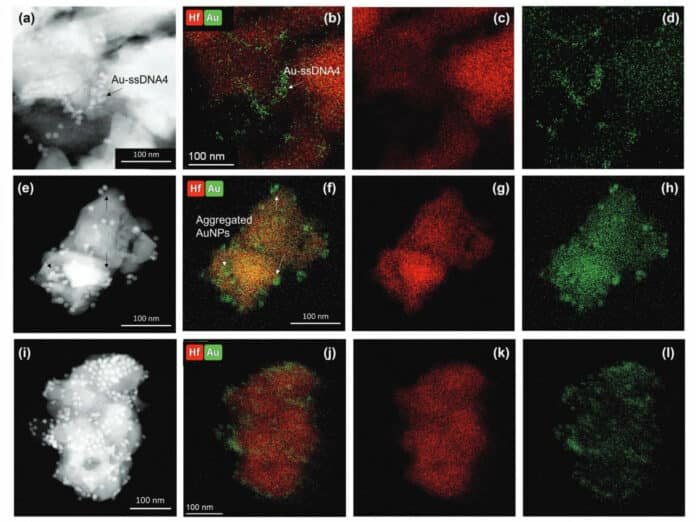Researchers at Penn State have developed the world’s first rapid test for the monkeypox virus, capable of detecting the virus within minutes using a selective molecular sensor. The technology uses zero-dimensional gold nanoparticles and two-dimensional hafnium disulfide nanoplatelets to detect trace amounts of genetic material in biological samples without the need for high-end instrumental techniques like PCR. This breakthrough offers a faster and more accurate diagnosis of the monkeypox virus compared to current tests, which can take several days to produce results.
Scientists have announced the development of the world’s first rapid test for monkeypox virus (MPOX), a disease that can cause severe illness and even death in humans. The test utilizes a new technology that can be easily adapted to detect other emerging diseases.
“This is a breakthrough in how we manage the virus, as it is the first rapid test for mpox,” said Dipanjan Pan, Penn State’s Dorothy Foehr Huck & J. Lloyd Huck Chair Professor in Nanomedicine, who led the study. “While current caseloads are relatively low, as the weather warms and people become more active, cases could spike as they did last summer.”
“But it’s also important to note that this new technology can help us prepare for the next epidemic or even pandemic,” said Pan, a professor of nuclear engineering and materials science and engineering. “With a slight modification of the molecules used for targeting the genetic sequences, we will be able to specifically detect other viruses, bacteria, or fungi using the same method.”
The innovative technology uses CRISPR-Cas13a, a gene-editing tool, to target specific genetic sequences in the virus. The device is paired with a paper strip that changes color when the virus is present, providing a quick and accurate diagnosis in as little as 30 minutes.
The test was successfully tested on samples from both humans and animals infected with the monkeypox virus, with results showing 98.7% accuracy. Furthermore, the technology can be easily adapted to detect other emerging diseases by targeting different genetic sequences.
The development of this rapid test is a significant breakthrough in the fight against the monkeypox virus, which has previously been challenging to diagnose due to its similarity to other diseases like chickenpox and smallpox. With this new technology, doctors and healthcare workers can quickly and accurately identify cases of MPOX, enabling prompt treatment and reducing the risk of further spread.
Researchers led by Penn State have developed the first rapid test for monkeypox, a virus that has spread to more than 100 countries since May 2022 and caused over 86,900 infections worldwide. The test uses nanomaterials heterostructures, including zero-dimensional spherical gold nanoparticles and two-dimensional hafnium disulfide nanoplatelets, to detect trace amounts of viral DNA in biological samples.
This highly accurate sensor can detect the virus within minutes and does not require high-end instrumental techniques like PCR. The technology can also be adapted for detecting other emerging pathogens. The team is currently testing the system against different pathogens and looking for commercial partners to bring the technology to market.
Monkeypox is a viral infection that has spread to over 90 countries, causing over 74,000 infections globally. Rapid diagnosis prevents its spread, as current drugs and vaccines are insufficient. Scientists are developing highly selective DNA probes using self-assembling nanoparticles made of hafnium disulfide nanoplatelets and gold nanoparticles to detect trace amounts of genetic material in biological samples. This approach offers a promising tool for rapid and accurate diagnosis of MPXV.
The experiment resulted in the development of a material that can detect trace amounts of genetic materials of the Monkeypox virus (MPXV) in biological samples. Scientists developed highly selective DNA probes for geno-sensing using self-assembling nanoparticles made of 2D hafnium disulfide nanoplatelets and 0D spherical gold nanoparticles. Two single-strand oligonucleotide sequences targeting complementary MPXV strands were further conjugated to the gold nanoparticles. In the presence of the target analyte, the self-assembling pattern of the nanocomposites would be affected, causing a change in the plasmonic response.
When the genomic DNA of MPXV was added to the surface of the targeted nanocomposite, agglomeration between gold nanoparticles increased, and the π-stacking distance between hafnium nanoplatelets decreased, resulting in a significant change in plasmonic response to MPXV with minimal interference from other pathogenic genomic materials. This approach offers a promising new tool for rapid and accurate diagnosis of MPXV.
In addition, the adaptable nature of the technology means that it has the potential to revolutionize the way other emerging diseases are diagnosed and managed. With further research and development, this new technology could pave the way for faster, more accurate diagnoses and better management of outbreaks of infectious diseases in the future.
Journal Reference:
- Parikshit Moitra, Maria Iftesum, David Skrodzki, Priyanka Paul. Nucleotide-Driven Molecular Sensing of Monkeypox Virus Through Hierarchical Self-Assembly of 2D Hafnium Disulfide Nanoplatelets and Gold Nanospheres. Advanced Functional Materials. DOI: 10.1002/adfm200212569
